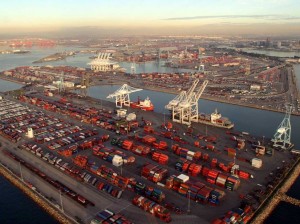 When we think of environmental policies that impact business, we don’t often think of increased profits. Too often the private sector is positioned at odds with efforts to address environmental issues through state and federal legislation. But alternatives to this false dichotomy exist and it’s important that we identify and act on these opportunities.
When we think of environmental policies that impact business, we don’t often think of increased profits. Too often the private sector is positioned at odds with efforts to address environmental issues through state and federal legislation. But alternatives to this false dichotomy exist and it’s important that we identify and act on these opportunities.
As an example, let me point to the adjacent ports of Long Beach and Los Angeles, which together make up the busiest container port complex in the Western Hemisphere. Last year, the ports moved the equivalent of nearly 15 million 20-foot-long containers. The ports contribute well over $100 billion and close to five million jobs to the national economy.
However, in the early 2000s, diesel emissions from the ports’ equipment, ships, trucks and trains had made the complex the largest single point generator of particulate and other diesel emissions in the Southern California region. A major problem was the tens of thousands of diesel trucks idling in long lines outside port terminals waiting to pick up cargo containers. As a member of the State Assembly I authored legislation reducing idle time outside the terminals to 30 minutes.
Despite the law, trucks continued to back up, mainly because the increasingly busy terminals were only open during the day. I challenged the ports to solve the problem or I would push through legislation to mandate terminals stay open longer. The ports and their stakeholders worked together to open the terminals at night, spreading out the traffic and cutting truck waiting times.
These and other measures led to a real shift in the entire culture at the ports–one focused on their environmental impacts. Today, the ports of Long Beach and Los Angeles have cut diesel emissions by more than 80 percent. They are now environmental role models for ports throughout the world.
Importantly, the ports actually made their operations more efficient by “going green,” simply because efficient terminals meant less waiting and less waiting meant fewer emissions.
Are we doing enough to strike a balance between government regulation and industry-led solutions? What challenges exist to duplicating these successes elsewhere? If “self-regulation” is not successful, what is the appropriate role of government in facilitating these improvements?
It’s ALL about Increasing Energy Efficiency. = Profit It was proven at the Port of LA, with the side benefit of Reduced Emissions. How many chimneys are poking out of… Read more »
As the COO of a small start-up biomass company with a highly innovative technology that can produce electricity as a unsubsidized cost of under $40/MWh, I encourage policy makers to… Read more »
I think California is doing a pretty good job of leading the nation in environmental protection and energy efficiency, in this instance and others. I work on transportation energy and… Read more »
I see several issues in areas such as Long Beach and Wilmington One issue is the transportation and shipment of Refinery Petroleum Coke from refineries in the area., which is… Read more »
There must be a balance between environmental goals and economic efficiency. A key problem with government regulators is they tend to be dominated by lawyers, who are rule oriented, have… Read more »
Seaports play an essential role in an increasingly globalized world economy. As ports expand to accommodate additional growth, the nature of their operations requires significant use of resources. What the… Read more »
You found a nice solution that turned out well for everyone Congressman Lowenthal. It did take your threat to create a response though. The Port’s action sure wasn’t voluntary. Evidently… Read more »